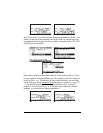
Page 17-13
The calculator provides for values of the upper-tail (cumulative) distribution
function for the F distribution, function UTPF, given the parameters
νN and νD,
and the value of F. The definition of this function is, therefore,
For example, to calculate UTPF(10,5, 2.5) = 0.161834…
Different probability calculations for the F distribution can be defined using the
function UTPF, as follows:
Θ P(F<a) = 1 - UTPF(
νN, νD,a)
Θ P(a<F<b) = P(F<b) - P(F<a) = 1 -UTPF(
νN, νD,b)- (1 - UTPF(νN, νD,a))
= UTPF(
νN, νD,a) - UTPF(νN, νD,b)
Θ P(F>c) = UTPF(
νN, νD,a)
Example: Given
νN = 10, νD = 5, find:
P(F<2) = 1-UTPF(10,5,2) = 0.7700…
P(5<F<10) = UTPF(10,5,5) – UTPF(10,5,10) = 3.4693..E-2
P(F>5) = UTPF(10,5,5) = 4.4808..E-2
Inverse cumulative distribution functions
For a continuous random variable X with cumulative density function (cdf) F(x) =
P(X<x) = p, to calculate the inverse cumulative distribution function we need to
find the value of x, such that x = F
-1
(p). This value is relatively simple to find for
the cases of the exponential and Weibull distributions
since their cdf’s have a
closed form expression:
Θ Exponential, F(x) = 1 - exp(-x/
β)
Θ Weibull, F(x) = 1-exp(-
αx
β
)
(Before continuing, make sure to purge variables
α and β). To find the inverse
cdf’s for these two distributions we need just solve for x from these expressions,
i.e.,
∫∫
∞−
∞
≤ℑ−=−==
t
t
FPdFFfdFFfFDNUTPF )(1)(1)(),,(
νν


















